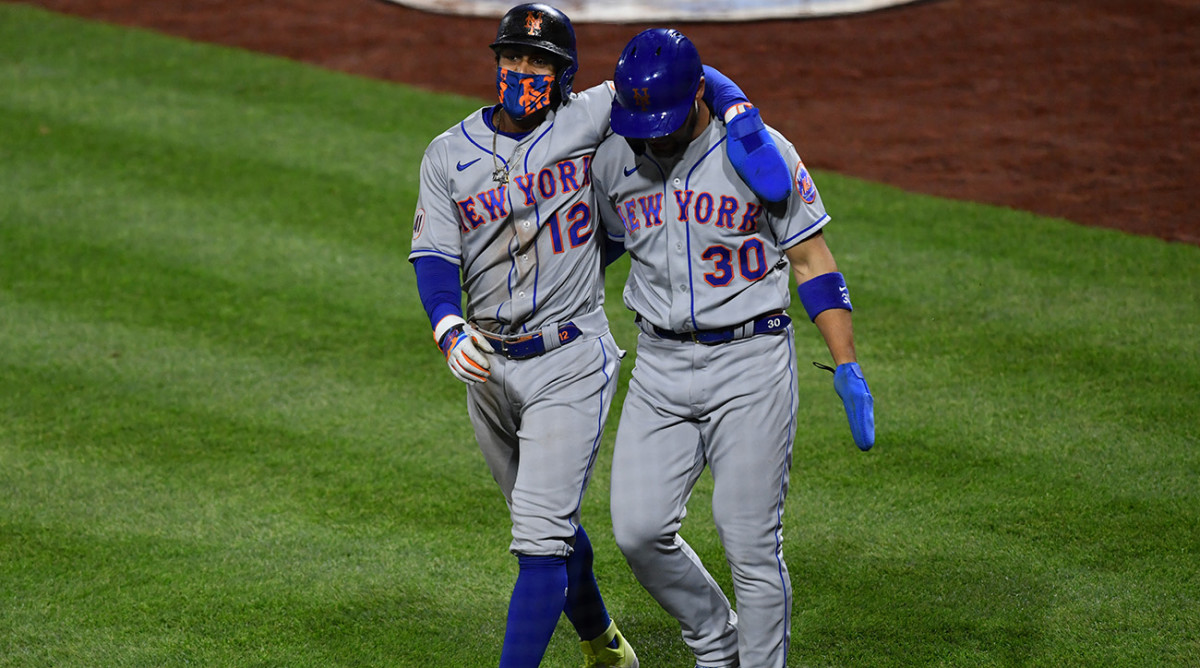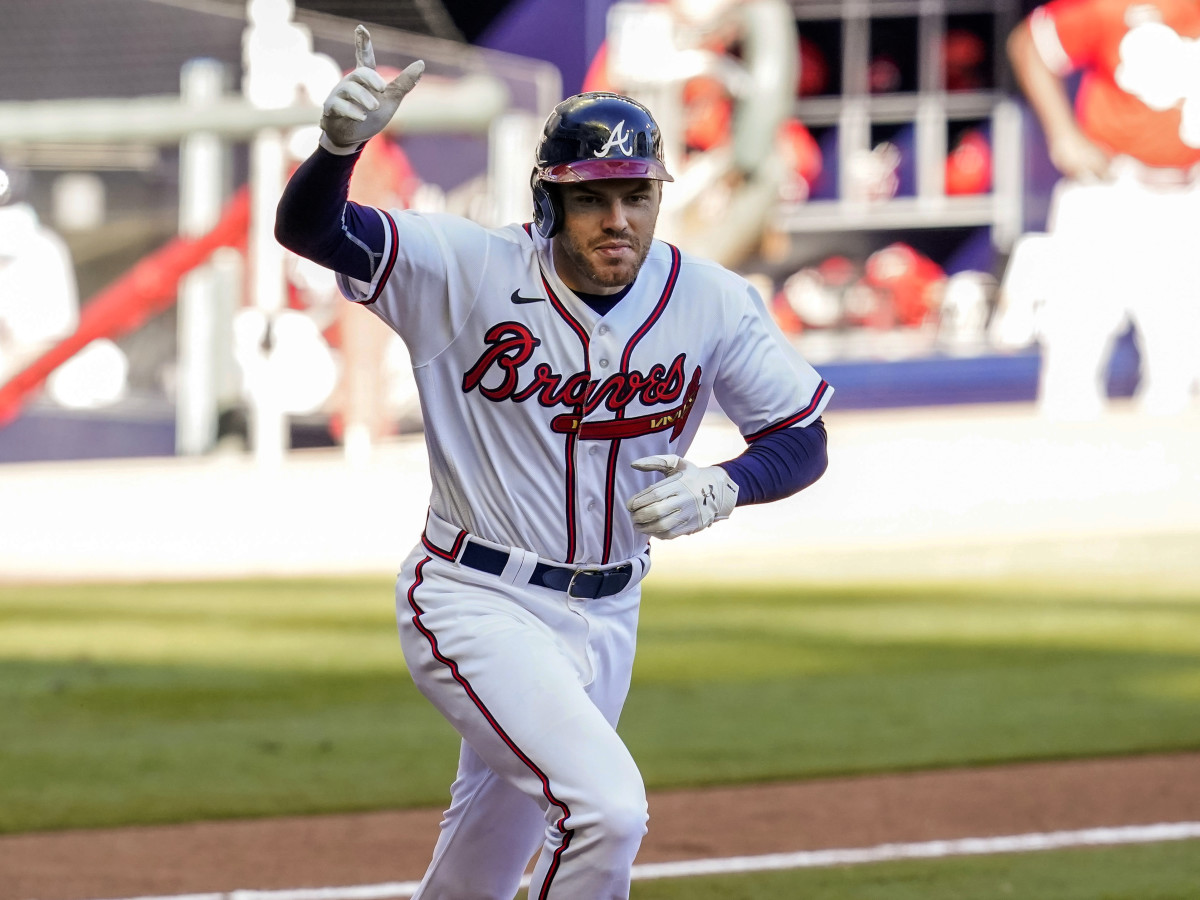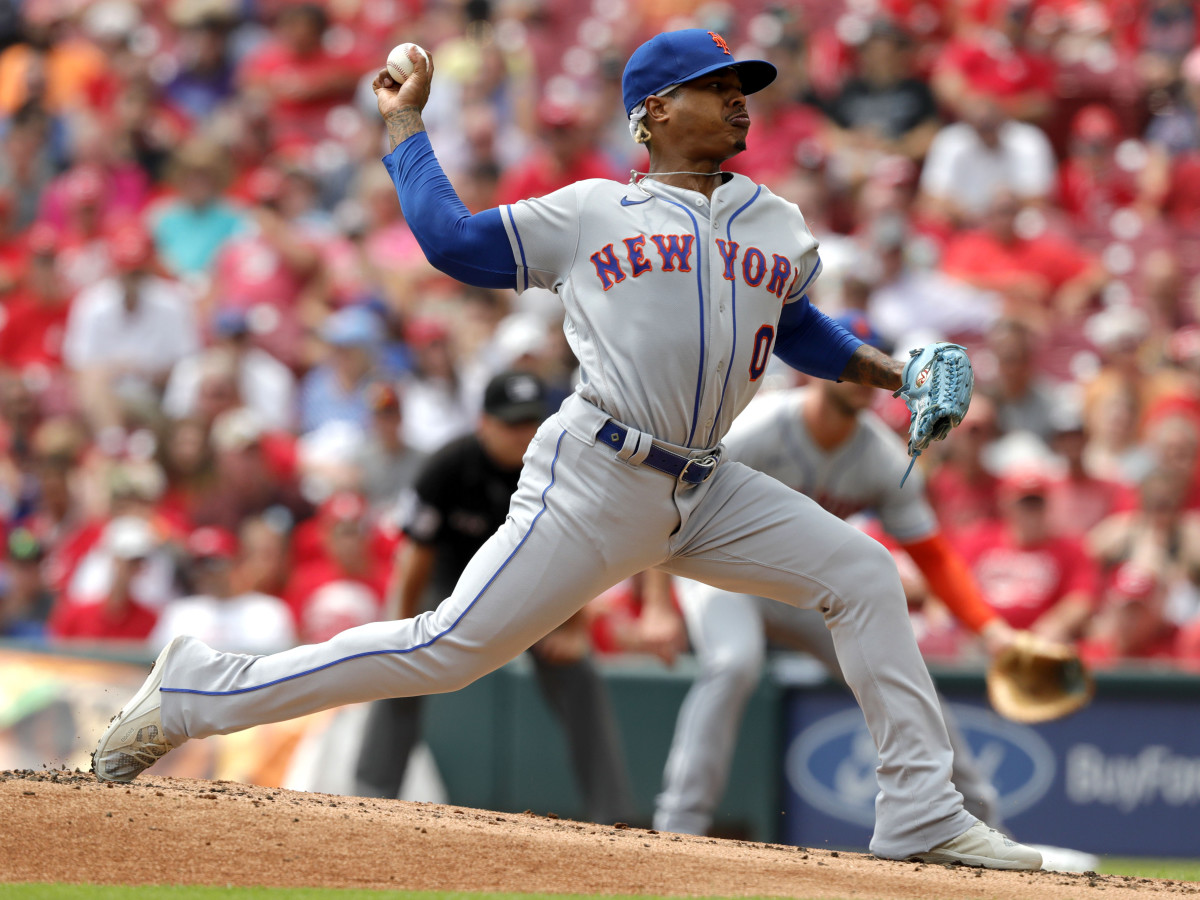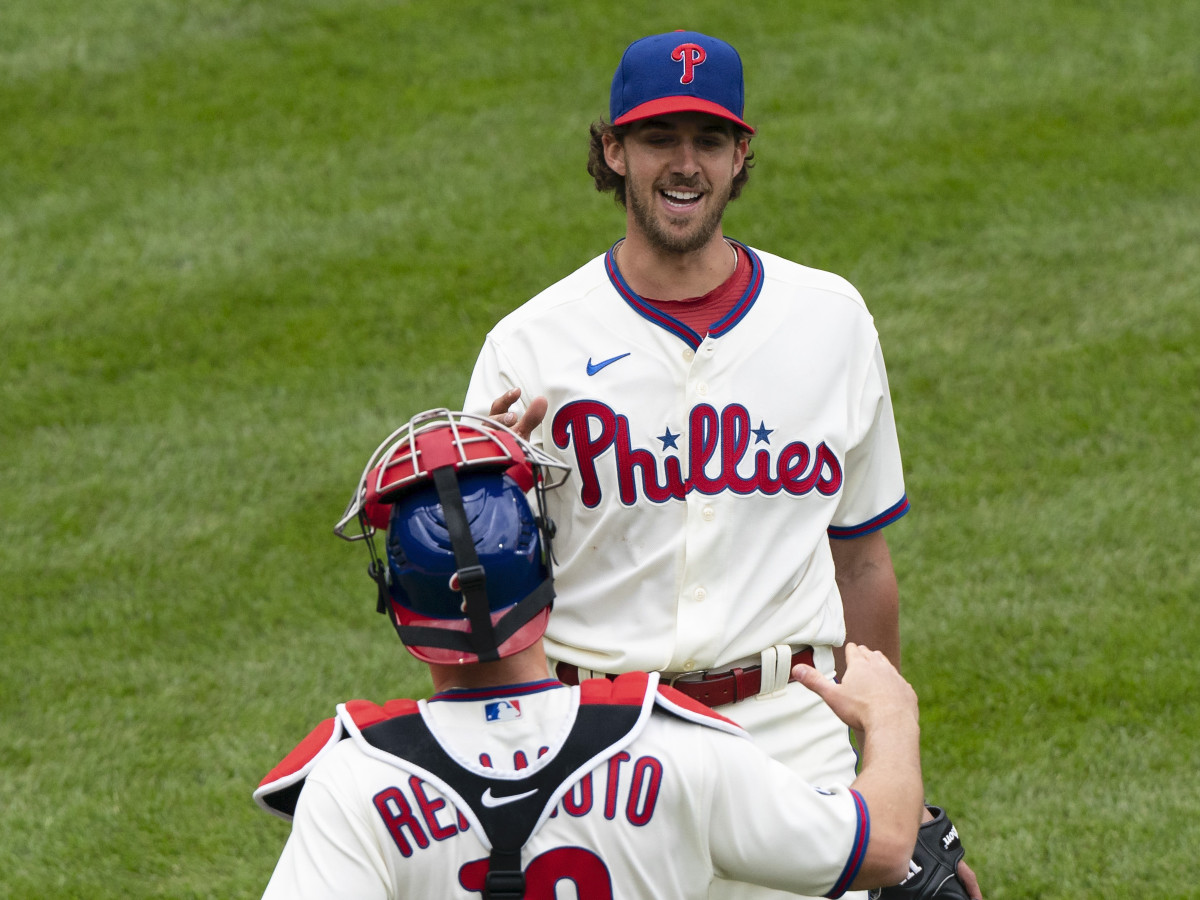Breaking Down the NL East Race After a Chaotic Trade Deadline

Welcome to The Opener, where every weekday morning you’ll get a fresh, topical column to start your day from one of SI.com’s MLB writers.
The National League East entered this season as a balanced division that could be won by any of four teams—the three-time defending division champion Braves, the offseason champion Mets, the 2019 World Series champion Nationals or the Bryce Harper–led Phillies. Even the Marlins had reasons for optimism after finishing in second place and winning a wild-card series in '20.
Fast forward to August, and looking at the NL East standings is like seeing a funhouse-mirror version of the preseason projections. It technically is the only division where the top four teams are all within seven games of one another, and the last-place Marlins aren’t buried nearly as deep as the rest of MLB’s cellar-dwelling squads. But that’s largely been due to a collective haze of ineptitude hanging over its contenders rather than any sort of aspirational competitive balance.

Fortunately, the trade deadline presented an opportunity for improvement, and three teams (New York, Philadelphia and Atlanta) decided to take advantage and push on for the division crown and accompanying bye into the divisional series playoff round, where anything can happen. With the final third of the season ready to kick into full gear, let’s take a look at the reset rosters of the Mets, Phillies and Braves, fittingly broken down into three sections—offense, rotation and bullpen—and try to forecast how the race for the NL East title will shake out.
Offense
Mets | Phillies | Braves | |
|---|---|---|---|
Runs/game | 3.81 | 4.57 | 4.75 |
Avg. | .236 | .242 | .242 |
OBP | .314 | .320 | .321 |
SLG | .385 | .402 | .428 |
HR | 113 | 120 | 148 |
wRC+ | 95 | 95 | 99 |
fWAR | 11.2 | 12.7 | 14.1 |
Deadline additions
Mets: INF Javier Báez
Phillies: SS Freddy Galvis
Braves: OF Joc Pederson, C Stephen Vogt, OF Adam Duvall, OF Eddie Rosario, OF Jorge Soler
Even though the Braves have fielded the division’s best offense, they were forced to upgrade this unit the most in the wake of Ronald Acuña Jr.’s season-ending knee injury and Marcell Ozuna’s domestic violence arrest. As a result, they’ll still run out a pretty fearsome lineup against left-handed starters—against whom the Mets have posted a 12–21 record, which is worse than all but three NL teams: the last-place trio of the Marlins, Pirates and Diamondbacks among NL teams. Austin Riley (seven homers in last nine games, 1.099 July OPS), Freddie Freeman (.375 batting average, 1.063 OPS in July) and Dansby Swanson (.944 OPS in July) have been red-hot lately to further bolster the offense’s outlook, while Pederson has a commendable .820 OPS in 16 games with Atlanta.

You can understand why Mets acting GM Zack Scott opted for quality over quantity here with the acquisition of Báez, as New York has already invested quite a lot into its offense and to a certain degree must simply hope for better results from its previous big-ticket acquisitions. Francisco Lindor is obviously the first name that comes to mind there, and he was finally starting to look like himself before an oblique injury sidelined him right after the All-Star break. We’ll see whether he can pick it up whenever he returns and pushes Báez to second base. Current second baseman Jeff McNeil has been excellent lately, but he can seamlessly slide into an everyday super-utility role. Of the eight Mets with at least 200 at bats, only Pete Alonso has an OPS above .750. That has to change for New York to fulfill its preseason hype.
The Phillies opted to focus on upgrading their pitching at the deadline, which was defensible given the obvious holes on the staff and Philadelphia’s limited farm system depth. Galvis will mostly serve as a defensive replacement in the late innings—another under-the-radar move that should help considerably because of the team's fielding woes. Still, this offense hasn’t quite lived up to its potential. Third base and center field were obvious weaknesses in the first half, though Alec Bohm’s bat finally woke up to the tune of an .869 OPS in July. Given how Atlanta rather easily exploited the outfield market at the last minute, it seems Philadelphia could have done the same to upgrade from journeyman Travis Jankowski in center.
Advantage: Braves
Rotation
Mets | Phillies | Braves | |
|---|---|---|---|
ERA | 3.37 | 4.44 | 4.00 |
FIP | 3.65 | 3.99 | 4.08 |
K% | 25.9% | 24.8% | 24.2% |
BB% | 7.2% | 7% | 8.7% |
fWAR | 10.2 | 9.9 | 7.9 |
Deadline additions
Mets: LHP Rich Hill, RHP Trevor Williams
Phillies: RHP Kyle Gibson
Braves: None
As is the case with Atlanta and its offense, the Mets were forced to add some starters despite boasting the division’s best rotation given how many of their pitchers are dealing with injuries. Jacob deGrom and Noah Syndergaard could both provide massive boosts if they return in September, which seems to be the best-case scenario at this point. Tylor Megill may currently be New York’s second-best starter following Taijuan Walker’s post–All-Star break blowups, Rich Hill’s lack of swing-and-miss stuff and Carlos Carrasco’s limited length as he continues to rebuild his stamina. This is not where the Mets expected to find themselves.

Philadelphia may regret parting with Spencer Howard, but it had to augment its rotation somehow, and Gibson will probably go down as the best NL East rotation addition this season once it’s all said and done, even if he’s unlikely to be quite as effective as he has been this year. If the Phillies do qualify for the playoffs, he’ll fit in nicely as the likely Game 3 starter behind Zack Wheeler and Aaron Nola.
Atlanta made its rotation upgrades during the offseason via Charlie Morton and Drew Smyly, who have both done their part and improved as the season has gone on. Max Fried’s regression and Ian Anderson’s shoulder injury both represent causes for concern down the stretch, though the emergence of 2016 second-round pick Kyle Muller (2.43 ERA, 33 strikeouts in 29 2/3 innings) and the return of early-season two-way success story Huascar Ynoa from his broken hand could be enough to push the Braves into the playoffs. Still, the ceiling of Atlanta's rotation isn’t as high as that of their rivals.
Advantage: Phillies
Bullpen
Mets | Phillies | Braves | |
|---|---|---|---|
ERA | 4.00 | 4.56 | 4.31 |
FIP | 4.16 | 4.59 | 4.13 |
K% | 25.6% | 23.2% | 23% |
BB% | 10.0% | 10.2% | 9.5% |
fWAR | 2.6 | 0.2 | 2.4 |
Deadline additions
Mets: None
Phillies: RHP Ian Kennedy
Braves: RHP Richard Rodríguez
Atlanta needed help here. Its bullpen has absorbed 23 losses, the fourth-most in the majors, while notching a league-low 14 wins. But I’m not sure the former Pirates closer Rodríguez was the answer here after his spin rate dramatically decreased following MLB’s crackdown on sticky substances. That unsurprisingly coincided with a downturn in results. He’s recorded a 4.50 ERA since June 21, with just seven strikeouts in 12 innings, compared to a 1.91 ERA with 24 strikeouts in 28 1/3 innings before that date.
Philadelphia’s bullpen issues have been well documented, and president of baseball operations Dave Dombrowski took a small step toward alleviating them by bringing in a new closer in 36-year-old righty Ian Kennedy … who promptly gave up at least one earned run in each of his first two appearances with the Phillies, albeit not in save opportunities. One interesting piece of fallout from that move is Ranger Suárez, who’s been Philly’s best reliever in 2021 with a sparkling 1.12 ERA, being subsequently stretched out for the rotation instead of returning to a setup role. So even if Kennedy does end up working out, the Phillies' bullpen may end up worse off than it was.
New York’s relief corps isn’t perfect. But with Edwin Díaz, Aaron Loup, Jeurys Familia and Trevor May combining for a sturdy back of the bullpen, it’s still the class of the NL East without any trade deadline additions.
Advantage: Mets

Verdict
In a race this close, naturally, every team emerges with one advantage. New York has another in that it owns a lead of 2.5 games over Philadelphia and 3.5 games over Atlanta. But with deGrom out until September, that seems especially precarious. FanGraphs’ playoff odds currently favor the Mets, giving them a 66.4% chance to win the division, while the Phillies (20.9%) and Braves (15.4%) trail. That seems too optimistic to me, though.
Atlanta has alternated losses and wins for its last 17 games, an MLB record that speaks to the frustrating inconsistency of Brian Snitker’s club. The Braves’ longest winning streak this season? Four games, which has happened twice. Their longest losing streak? Also four games, which has happened four times. If they’re going to make a move, it may have to be now. They are entering the easiest remaining run of their schedule, with games against the Cardinals, Nationals, Reds, Nationals again, Marlins and Orioles up next. But it’s still really hard to get behind a club missing its MVP in Acuña.
If I had to pick a team to represent the NL East, it’d be the Phillies. They possess the division’s healthiest rotation and a lineup that’s shown the capability to score enough to win and has room to grow. They also have the easiest remaining schedule remaining, per Tankathon, after facing the league’s 11th-toughest schedule thus far. Meanwhile, the Mets have seemingly sleepwalked through the season while facing the league’s second-easiest schedule and have the eighth-toughest slate remaining. While New York has certainly suffered from bad luck on offense, losing its MVP in deGrom for at least another month is nearly akin to the Braves' playing without Acuña. In a division where no one has managed to separate themselves from the back, something as random as health may end up being the differentiating factor.
More MLB Coverage:
• How Baseball's Superteam Can Still Be Stopped
• Chaotic Trade Deadline Changed the Game
• MLB Trade Deadline Winners and Losers
• Yankees Boost Lackluster Offense With Anthony Rizzo Trade
